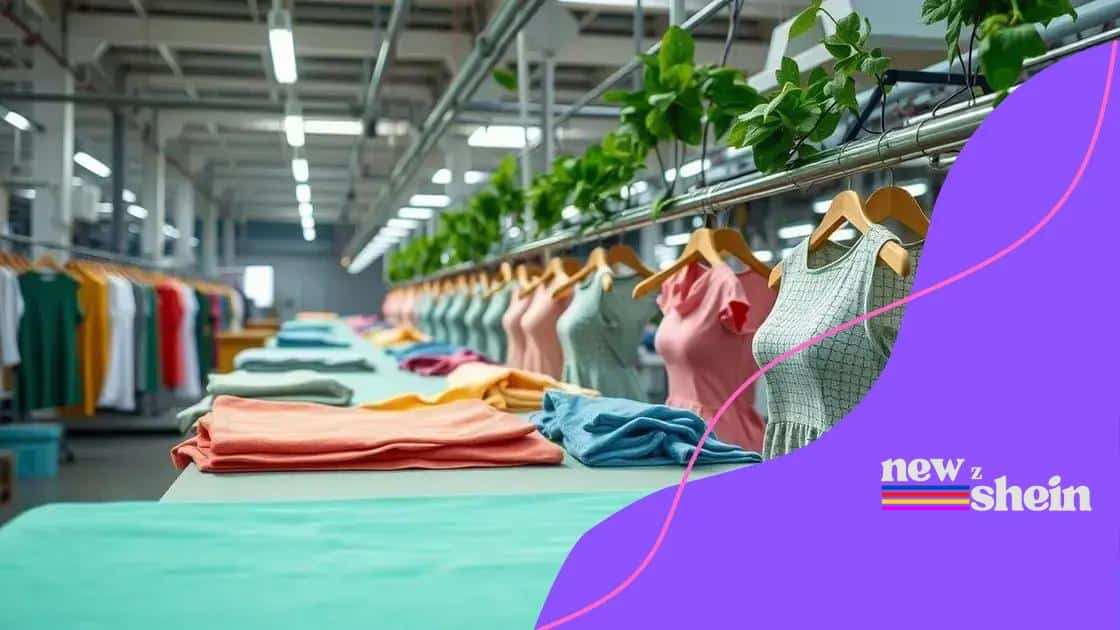Shein’s investment in green manufacturing transforms fashion

Shein’s investment in green manufacturing focuses on sustainable practices, including the use of eco-friendly materials and innovative technologies, to meet growing consumer demand for environmentally responsible fashion.
Shein’s investment in green manufacturing marks an important shift in the fashion industry. Have you ever wondered how a major brand can influence eco-friendly practices? Let’s dive into how Shein is changing the game.
Understanding Shein’s approach to sustainability
Understanding Shein’s approach to sustainability is pivotal in grasping how large retail brands can foster eco-friendly practices. The company has initiated several programs aiming to improve its environmental impact, demonstrating a commitment to a greener future.
Key Initiatives in Sustainability
Shein has focused on various aspects to enhance its sustainability initiatives. These initiatives include:
- Adopting sustainable materials, such as organic cotton and recycled polyester.
- Implementing energy-efficient manufacturing processes to reduce carbon emissions.
- Promoting recycling programs for its customers to manage waste effectively.
Furthermore, Shein actively collaborates with various organizations to promote eco-friendly practices across the fashion industry. This effort not only improves its brand image but also encourages consumer participation in responsible fashion choices.
Consumer Engagement and Feedback
Consumer response to Shein’s green initiatives has been notably positive. Many customers express a growing appreciation for brands committed to sustainability. This shift is important, as it plays a critical role in the decision-making process for shoppers today.
By engaging with consumers about their values, Shein shapes its product offerings to align with a demand for sustainability. Many shoppers now prefer to support brands that focus on the environment, making sustainability not just a trend but a fundamental aspect of their purchasing habits.
In conclusion, Shein’s strategic approach to sustainability showcases its promise to balance style with responsibility.
Current initiatives in green manufacturing
Shein is actively pursuing current initiatives in green manufacturing to reshape its production processes. By focusing on innovation, the brand aims to reduce its environmental footprint and promote sustainability.
Innovative Materials
One significant initiative involves the use of innovative materials. Shein has started incorporating:
- Recycled fabrics that minimize waste and reduce resource consumption.
- Organic materials which are grown without harmful chemicals.
- Biodegradable textiles that help lessen landfill impact.
These materials not only support eco-friendliness but also enhance product appeal to a conscious consumer base.
Efficient Production Techniques
Shein is also focusing on streamlining its production techniques. By adopting energy-efficient machinery and methods, the brand is decreasing its energy consumption significantly. Using advanced technology helps in:
- Reducing waste generated during production.
- Minimizing water usage with closed-loop systems.
- Lowering carbon emissions through smarter logistics.
Such steps are essential, as they lead to a more sustainable overall production cycle. This approach not only benefits the planet but also helps in maintaining cost efficiency.
Shein continues to explore partnerships with sustainability-focused organizations. By doing so, the brand can stay ahead in implementing practices that are not just trendy but essential for the future of fashion.
The impact of eco-friendly practices on production costs

The impact of eco-friendly practices on production costs is a critical discussion in the fashion industry. Many brands, including Shein, recognize that adopting sustainable methods can significantly influence their financial outcomes.
Cost Savings through Efficiency
By implementing eco-friendly practices, brands often see cost savings in various areas. One primary factor is efficiency. For instance, energy-efficient machinery:
- Reduces power consumption, leading to lower utility bills.
- Minimizes waste, allowing the use of materials more effectively.
- Streamlines production processes, cutting time and labor costs.
These improvements help to offset the initial investments involved in transitioning to greener technologies.
Long-term Financial Benefits
In addition to immediate savings, eco-friendly practices can yield long-term financial benefits. Companies may experience:
- A boost in sales as more consumers prefer to buy sustainable products.
- Improved brand loyalty, resulting in repeat purchases.
- Reduced regulatory costs by complying with environmental regulations.
As consumer demand for sustainable goods grows, businesses that prioritize eco-friendly practices can position themselves favorably in the market. Additionally, such practices enhance a brand’s image, making it more attractive and trustworthy to potential customers.
Ultimately, while the initial cost of going green may seem high, the long-term advantages often outweigh these expenses. Eco-friendly practices not only help the planet but also can positively affect a company’s bottom line.
Consumer reactions to Shein’s sustainability efforts
Understanding consumer reactions to Shein’s sustainability efforts is essential for evaluating the success of its green initiatives. Many shoppers are increasingly conscious of environmental issues and prefer brands that demonstrate a commitment to sustainability.
Positive Feedback on Initiatives
Many consumers have responded positively to Shein’s efforts to adopt more sustainable practices. They appreciate:
- Transparency in production processes, which builds trust in the brand.
- Eco-friendly materials being used in new collections, showcasing a genuine commitment to the environment.
- Engagement in eco-conscious marketing campaigns that resonate with their values.
This feedback is crucial as it indicates a shift in consumer preferences toward sustainable fashion.
Demand for Continuous Improvement
While many customers welcome Shein’s changes, there are also expectations for continuous improvement. Consumers often express a desire for:
- More affordable sustainable options that fit their budgets.
- Greater access to information about supply chain practices.
- Continued innovations in creating zero-waste collections.
These points highlight that consumers are not just passive observers; they actively seek brands that align with their environmental values.
Furthermore, online reviews and social media discussions often reflect a mix of enthusiasm and skepticism. Some customers remain cautious about the impact of Shein’s sustainability practices, arguing that the fast fashion model, in general, needs deeper systemic changes.
Ultimately, tracking consumer reactions helps Shein understand its market positioning while informing future sustainability strategies. In a competitive landscape, brands cannot ignore the voices of their customers who prioritize environmental responsibility.
Future trends in sustainable fashion and Shein’s role
Future trends in sustainable fashion are shaping the way brands like Shein operate. As consumers become more environmentally conscious, the demand for ethical practices in clothing production continues to rise. This trend is not just about reducing waste but also about embracing innovative solutions that align with consumer values.
Emerging Sustainable Materials
One of the key trends involves the use of new sustainable materials. Brands are investing in:
- Biodegradable textiles that break down more easily after use.
- Recycled fabrics that help minimize waste by reusing old materials.
- Plant-based materials that reduce reliance on petroleum-based fabrics.
Shein is expected to expand its offerings of such materials, appealing to eco-friendly shoppers.
Technological Innovations
Another important trend in sustainable fashion is technological innovation. New technologies are revolutionizing production methods, leading to:
- More efficient 3D printing techniques that reduce fabric waste.
- AI-driven inventory management that minimizes overproduction.
- Wearable technology that may include sustainable fibers.
By adopting these technologies, Shein can not only improve efficiency but also strengthen its commitment to sustainability.
Furthermore, the trend of circular fashion is gaining momentum. This concept encourages recycling and upcycling of clothing throughout its life cycle. Shein may implement take-back programs, allowing customers to return used items in exchange for discounts or rewards, promoting sustainability.
As consumers seek brands that align with their values, Shein’s active participation in these trends can help solidify its position in the competitive fashion landscape. By staying ahead of emerging practices and technologies, Shein can cater to the growing market of eco-conscious consumers.
FAQ – Questions about Shein’s sustainability efforts
What eco-friendly materials is Shein using?
Shein is incorporating recycled fabrics, biodegradable textiles, and organic materials to promote sustainability in its clothing lines.
How does Shein implement technology in sustainable production?
Shein utilizes energy-efficient machinery, 3D printing, and AI-driven inventory management to reduce waste and improve production efficiency.
How do consumers respond to Shein’s eco-friendly initiatives?
Many consumers appreciate Shein’s efforts, valuing transparency and eco-friendly options, but they also expect ongoing improvements in sustainability practices.
What future trends are emerging in sustainable fashion?
Future trends include the rise of circular fashion, increased use of sustainable materials, and a greater focus on brand transparency regarding environmental practices.





